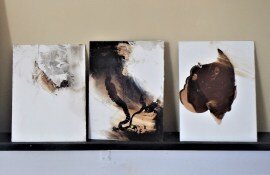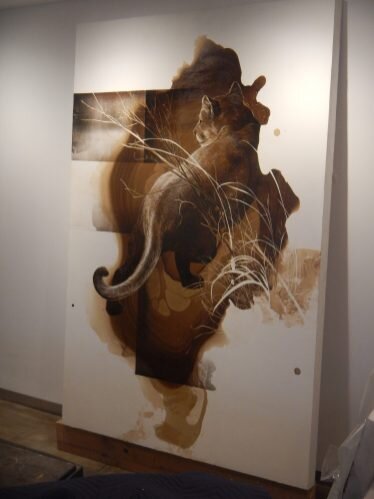James Griffith: Matter as Light
James Griffith; Image courtesy of the artist and Craig Krull Gallery
“Learn how to see. Realize that everything connects to everything else.” ~Leonardo da Vinci
Written by Gary Brewer
APRIL 24, 2020
Worlds within worlds; a linked verse of insights can tell the story of our lives and reflect the mystery of existence.
Alchemists sought to discover the interconnectedness of all things: of how to transform common base material into gold. Those efforts became a proto-science, developing chemistry, medicines and pigments and also expressed a metaphoric journey of our soul becoming illuminated through spiritual metamorphosis.
We are seekers of knowledge and from the rich humus upon which we walk; histories unfold in the hands of those gifted in unweaving its tapestry of knowledge. It is an alchemical pursuit that has fascinated the human species since ancient times; it is also the prime mover in the work of the artist James Griffith.
James is an artist to whom materiality and light express the poetics of mind and spirit. They are the primal forces that have shaped his work and thoughts since he was a young child. I asked him what it is he is doing as an artist. He answered, with a mix of philosophical depth and a mirthful sense of humor, at the limits of our ability to understand truth, “ To scoop up the primordial ooze from the earth, and to hold it up to the light to search for secrets that reveal the origin of our existence, is a gesture I use to explain my pursuit as an artist. As a child I used to collect dirt from different locations and put them into small vials. I would then add water and shake them up, believing that I would be able to see the way that geological forces have shaped the earth. I am able to connect the dots from my childhood to the present of my pursuit to try and gain insight into the secrets of our origins.”
Many years ago, James was working on a series of paintings based on Galileo’s watercolors of the moon. He had become weary of the expense of oil paint and used some asphaltum; an inexpensive material that he had used in the past for printmaking. He had a small exhibition of his new work at his studio and a friend who came by spoke with him about this work and said, ”I know where you can get buckets of this material for free, go to the La Brea Tar pits, they are giving it away.”
Thus, in a serendipitous moment of fate working in its mysterious ways, a new medium was born, that carried within it a content that spoke volumes for an artist whose interest in natural history and of the forces that shape life on earth, have guided his aesthetic impulse for decades.
James Griffith; Image courtesy of the artist and Craig Krull Gallery
As we spoke, he showed me various works in progress, at different stages of development. (Normally I visit with the artist in their studios, but due to our current moment in time as the corona virus envelopes the world and we shelter in place, we communicated via Facetime. He pointed his phone camera around his studio soI could see the works in progress- an adaptation that may become a norm as this new reality becomes part of our world.)
James begins a painting by applying white paint to the aluminum panels that he works on. The surface moves from smooth to heavy impasto, to create a topography that will affect the application of tar to the surface in unexpected ways. James mixes his earthly substance with various thinners; lighter fluid, rubbing alcohol, kerosene and an assortment of other materials; each which effect the spread his medium as he pours and brushes it onto the surface of these panels. Initially he lays them flat on a table to pour and manipulate the tar into spontaneous, abstract, process-based shapes. When they dry, he hangs them on the wall and in a method of intuition and instinct he waits until he can sense what plant or animal will inhabit the space that he has created.
Sometimes he begins a priori and creates a stencil to make a predetermined shape for a deer or a bear, for instance. Once the image is conceived, he works with fine tools to scratch away- in a process similar to scratch board- thin lines that articulate the details of his subject. Countless hours are spent articulating space and light with a meticulous rendering of the fur or feathers of his subjects. He spoke of wanting to convey tenderness and a love for each living thing. “I think of my portraits of animals as a form self portraiture. Each animal has a character; the humility and vulnerability of a mouse, or the strength and power of a mountain lion. Each creature reflects an aspect of self that I feel in the work. I do not think about it while I am painting, but when they are complete, I can see an aspect of my self in the image.”
James and I spoke about E.O. Wilson’s notion of ‘biophillia’, a love for all living things. That only by loving something can one be moved to protect it. His paintings of plants and animals are in part, a way to reflect this love he has for nature and his hope that a viewer would be moved to experience that feeling, and in turn, to help alter the disastrous course of our culture’s impact on nature.
His newest paintings as seen in Terrestrial and Celestial last November at Craig Krull Gallery of the sun and solar events, are a response to his paintings of flora and fauna. Feeling the weight of our current political climate and a sense of despair that people are not changing quickly enough, he needed to get some philosophical distance from the vicissitudes of human folly. James looked to our Sun and the Janus-faced simultaneity of it being a destructive force and a giver of life. “ I needed to take a breath, to get some distance from feeling sorrow for our world and the impact that we have upon it. To think in larger terms; in time scales that put things in perspective. Our existence on earth is a small event in geological time and making paintings of our star and the galactic scale of our universe is a way to gain some balance and to meditate on forces that are both destructive and generative.”
These new paintings are a brilliant realization of the power of his technique and materials. James has said that he was always drawn to the quality of light that can be captured in painting and that it is the most important aspect of his interest in art. These dark, near black, brown and sepia hues exploding in spills, splashes and watery veils convey a range of organic processes. To then scratch through the surface to reveal the luminous white beneath and with incised lines to articulate the storms of explosive solar events on the surface of the sun, is a profound blend of subject, materials and intentions. These works encapsulate so many themes and interests of a life lived exploring our origins. Indeed. stars are the crucible from which all of the elements necessary for life are created: it is a singular gestalt of the history of everything.
Art is philosophy embedded in images and matter. We experience the power of ideas as they are communicated through subject matter, materials, colors and composition. They are encoded into these through the somatic memory of the life of an artist, the times in which they lived and their visceral response to them; conveyed in a Morse code of synaptic dots and dashes expressed through the touch of one’s fingertips.
The earthy material that James uses is the result of millions of years of ancient organisms: algae and zooplankton, buried in conditions without oxygen, breaking down and metamorphosing over millions of years, transformed into oil, asphalt and tar. James Griffith chose this gooey thick material, or one might say it chose him, waiting through the millennia to become a host for a physical record of the life of this planet and as a medium for an artist to express deep philosophical meditations on time, space and the contours of this living world.

















